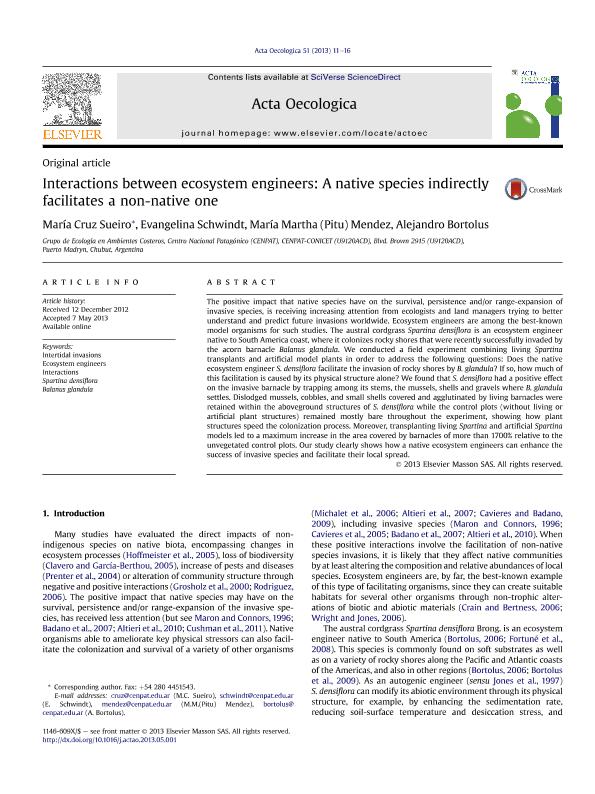Mostrar el registro sencillo del ítem
dc.contributor.author
Sueiro, Maria Cruz

dc.contributor.author
Schwindt, Evangelina

dc.contributor.author
Mendez, María Martha

dc.contributor.author
Bortolus, Alejandro

dc.date.available
2016-04-22T21:48:48Z
dc.date.issued
2013-08
dc.identifier.citation
Sueiro, Maria Cruz; Schwindt, Evangelina; Mendez, María Martha; Bortolus, Alejandro; Interactions between ecosystem engineers: a native species indirectly facilitates a non-native one; Elsevier Masson; Acta Oecologica; 51; 8-2013; 11-16
dc.identifier.issn
1146-609X
dc.identifier.uri
http://hdl.handle.net/11336/5351
dc.description.abstract
The positive impact that native species have on the survival, persistence and/or range-expansion of invasive species, is receiving increasing attention from ecologists and land managers trying to better understand and predict future invasions worldwide. Ecosystem engineers are among the best-known model organisms for such studies. The austral cordgrass Spartina densiflora is an ecosystem engineer native to South America coast, where it colonizes rocky shores that were recently successfully invaded by the acorn barnacle Balanus glandula. We conducted a field experiment combining living Spartina transplants and artificial model plants in order to address the following questions: Does the native ecosystem engineer S. densiflora facilitate the invasion of rocky shores by B. glandula? If so, how much of this facilitation is caused by its physical structure alone? We found that S. densiflora had a positive effect on the invasive barnacle by trapping among its stems, the mussels, shells and gravels where B. glandula settles. Dislodged mussels, cobbles, and small shells covered and agglutinated by living barnacles were retained within the aboveground structures of S. densiflora while the control plots (without living or artificial plant structures) remained mostly bare throughout the experiment, showing how plant structures speed the colonization process. Moreover, transplanting living Spartina and artificial Spartina models led to a maximum increase in the area covered by barnacles of more than 1700% relative to the unvegetated control plots. Our study clearly shows how a native ecosystem engineers can enhance the success of invasive species and facilitate their local spread.
dc.format
application/pdf
dc.language.iso
eng
dc.publisher
Elsevier Masson

dc.rights
info:eu-repo/semantics/openAccess
dc.rights.uri
https://creativecommons.org/licenses/by-nc-nd/2.5/ar/
dc.subject
Intertidal Invasions
dc.subject
Ecosystem Engineers
dc.subject
Interactions
dc.subject
Spartina Densiflora
dc.subject
Balanus Glandula
dc.subject.classification
Ecología

dc.subject.classification
Ciencias Biológicas

dc.subject.classification
CIENCIAS NATURALES Y EXACTAS

dc.title
Interactions between ecosystem engineers: a native species indirectly facilitates a non-native one
dc.type
info:eu-repo/semantics/article
dc.type
info:ar-repo/semantics/artículo
dc.type
info:eu-repo/semantics/publishedVersion
dc.date.updated
2016-05-06 15:52:43.262787-03
dc.journal.volume
51
dc.journal.pagination
11-16
dc.journal.pais
Francia

dc.journal.ciudad
Paris
dc.description.fil
Fil: Sueiro, Maria Cruz. Consejo Nacional de Investigaciones Científicas y Técnicas. Centro Nacional Patagónico; Argentina
dc.description.fil
Fil: Schwindt, Evangelina. Consejo Nacional de Investigaciones Científicas y Técnicas. Centro Nacional Patagónico; Argentina
dc.description.fil
Fil: Mendez, María Martha. Consejo Nacional de Investigaciones Científicas y Técnicas. Centro Nacional Patagónico; Argentina
dc.description.fil
Fil: Bortolus, Alejandro. Consejo Nacional de Investigaciones Científicas y Técnicas. Centro Nacional Patagónico; Argentina
dc.journal.title
Acta Oecologica

dc.relation.alternativeid
info:eu-repo/semantics/altIdentifier/url/http://www.sciencedirect.com/science/article/pii/S1146609X13000787
dc.relation.alternativeid
info:eu-repo/semantics/altIdentifier/doi/http://dx.doi.org/10.1016/j.actao.2013.05.001
dc.relation.alternativeid
info:eu-repo/semantics/altIdentifier/doi/10.1016/j.actao.2013.05.001
Archivos asociados
